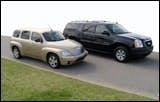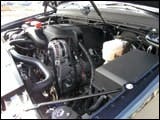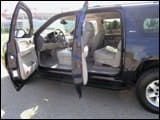FlexFuel V-8 is a Vortec 5300 that operates on eight or four cylinders, and can burn an ethanol-gasoline blend or straight gasoline. The vehicle's fuel system is also toughened against alcohol's corrosive tendencies.
Eight people can be accommodated in the big Yukon XL, and there's still nearly 4 feet of cargo space behind the third row of seats. They can be removed to make even more room.
General Motors is bullish on ethanol, and top executives feel they have some good reasons. You've heard them before: America is far too dependent on foreign oil, especially because much of it comes from unfriendly and/or unstable countries. Alternative fuels can help us get away from oil, and a logical variety is ethanol refined from corn and other home-grown crops. It could put a big dent in the oil market, resulting in fewer geopolitical problems and lower energy prices.
GM is putting its money where its mouth is, building cars and trucks that can burn an ethanol-gasoline mixture. These include pickups and sport-utility vehicles that are commonly used in the construction industry. One is the 2007 GMC Yukon XL you see here. Except for its fuel, it runs like any of the other big SUVs that were available for driving by customers, dealers and press reporters at a recent "all brand" event in Nashville, Tenn.
Yes, hybrid power trains get a lot of attention from the press. But hybrids, which GM and other builders also make, are relatively expensive. And they're effective only in city driving, where frequent stops generate energy that's reused for launches. Ethanol, if you can get it, can work in all kinds of driving, so I was drawn to this big black Yukon with its FlexFuel badge.
For fun I posed it with another SUV that's worth considering as a fuel-saver: Chevrolet's HHR, a happy looking compact with snappy performance, "retro" styling and up-to-date utility. It's got decent interior space for passengers and gear, and most seats fold down flat to maximize cargo room. It reminded me more of Chrysler's PT Cruiser than any truck, though the HHR's roof is lower and its styling suggests late '40s rather than the PT's late '30s. Once you've stomached their compact size and anemic-sounding engines, these cars are as useful as many light trucks.
As with the PT, the HHR's four-cylinder gasoline engine actually delivers sparkling acceleration. It delivers fuel economy well into the 20-mpg range, compared to the teens turned in by full-size trucks and SUVs. If all you're going to haul around is yourself, and assuming you're not of outsize proportions, wouldn't you like to save hundreds and maybe thousands of dollars a year in fuel by using something like this?
Maybe not, and certainly not if you regularly transport lots of people and gear, pull heavy trailers, or just like the feel of a big truck. That's why GM's Suburban has grown popular since its introduction about 70 years ago. For years it was a panel truck with windows and an extra bench seat, and it did things that car-based sedans and station wagons couldn't.
Like the pickups on which they're based, Chevy and GMC Suburbans grew more comfortable and capable over the years. A few years ago, in a move toward badge differentiation, the GMC version got the Yukon XL moniker and slight front-end styling modifications. Chevy and GMC light trucks and SUVs are otherwise virtual clones, but that doesn't detract from the fact that they're fine vehicles. Yes, sales of all SUVs are down since the latest fuel-price spikes, but they're still useful and price cuts and rebates keep them affordable.
Last fall, GM updated its full-size SUVs, primarily the shorter Chevy Tahoe and GMC Yukon but also the sumptuously appointed Cadillac Escalade (now the Number One selling executive fleet vehicle, GM says) with sleeker exteriors and upscaled interiors. Those changes also affected the Suburban and Yukon XL (meaning extra long), like the 1500-series half-ton one you see here. The styling includes Caddy-like projector-beam headlights, and nice SLT interior trim has leather-covered seats, so the vehicle was a pleasure to see and be in.
XL could also mean extra large, and it took me a few minutes to get accustomed to the vehicle's 18.5-foot length. There are three rows of seats and enough real room for seven adults and their baggage, because there's still several feet of cargo room behind the third row. But the XL proved surprisingly nimble and very quiet and comfortable.
The ride immediately showed up as smooth and steady, though I didn't take it over any pavement or off-road terrain that was anywhere near rough. Later I drove a Chevy Suburban over a longer course that included freeways and city streets, some of them with broken pavement, and the improved suspension — with an independent front and five-link rear, all on coil springs — and long 130-inch wheelbase sopped up anything it encountered.
The 5.3-liter (325-cubic-inch) V-8 had good power and operated well with the Hydra-matic four-speed automatic transmission. A 6-liter (364-cubic-inch) V-8 is also available; and the zoot-suity Denali trim package, which rivals the Caddy Escalade, includes a new 6.2-liter (378-cubic-inch) V-8 and equally new six-speed Hydra-matic that I didn't get to sample.
The Vortec 5300 and 6000, as they're called, have a feature called Active Fuel Management that can save some gas money. Formerly called Displacement on Demand, the system electronically cuts fuel to four cylinders and allows their pistons to freewheel. This saves about 10 to 12 percent in fuel compared to a full-time V-8. If you observe carefully, you might hear or feel a sort of click as the engine goes from eight to four cylinders and back again, but most of the time you can't tell unless you look at a readout on the dash, which indicates which mode it's in. This works whether an engine is burning gasoline, as it was this day, or a gasoline-ethanol blend.
The strategic idea of the FlexFuel feature is to displace petroleum-derived gasoline with ethanol. Almost any vehicle in the country will handle fuel with 10 percent ethanol, which is sold in several farm-belt states. California and other states are replacing the toxic MTBE oxygenating additive with 10 percent ethanol, which does the same thing while helping boost octane. Eventually this fuel — call it E10 — will be common.
A FlexFuel engine will burn any amount of ethanol. But it takes a higher percentage to cut emissions and greenhouse gases, and 85 percent ethanol, or E85, is the practical maximum because a small amount of gasoline is needed for cold starting. That much ethanol will eat up pieces of a normal vehicle's fuel system, so a FlexFuel vehicle's system has special materials that are impervious to ethanol.
The capability to burn straight gasoline is important because E85 filling stations are now scarce. There are only 700 E85 stations in the United States, most of them in the Upper Midwest, especially Minnesota. GM says it's working with oil companies and other car/truck builders to increase that number. They hope it'll be 2,000 stations in a few years. That's still not enough, but the capability to burn E85 makes "big-picture" sense for the nation, even if the owner can't always use it.
Fuel flexibility is what made consumers in Brazil finally embrace ethanol as a workable fuel in the early '90s. They understand that it delivers 25 percent fewer miles per gallon compared to gasoline, but if it's cheaper, the costs even out. Brazil began working on its "alcool" (Portuguese for alcohol) program back in the early '80s, and the country reportedly now produces more energy than it imports. Refiners there use sugar cane, grown on vast land tracts in near equatorial heat, as the source of ethanol.
We don't grow a lot of sugar cane in the comparatively cool United States, but sugar beets, wood chips, saw grass and other sources of cellulose could be refined into ethanol, GM says. It touts corn because we grow a lot of it and people understand it. So you could say that FlexFuel is a corny, good-ol'-USA solution to a vexing problem. We'll see where the feature takes us. If it's in a Yukon XL or its Chevy Suburban counterpart, we'll get there in style and class while hauling just about anything.








